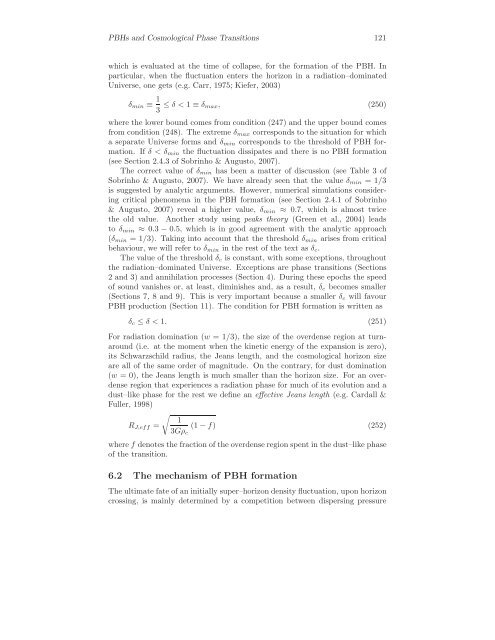Primordial Black Holes and Cosmological Phase Transitions Report ...
Primordial Black Holes and Cosmological Phase Transitions Report ...
Primordial Black Holes and Cosmological Phase Transitions Report ...
You also want an ePaper? Increase the reach of your titles
YUMPU automatically turns print PDFs into web optimized ePapers that Google loves.
PBHs <strong>and</strong> <strong>Cosmological</strong> <strong>Phase</strong> <strong>Transitions</strong> 121<br />
which is evaluated at the time of collapse, for the formation of the PBH. In<br />
particular, when the fluctuation enters the horizon in a radiation–dominated<br />
Universe, one gets (e.g. Carr, 1975; Kiefer, 2003)<br />
δmin ≡ 1<br />
3 ≤ δ< 1 ≡ δmax, (250)<br />
where the lower bound comes from condition (247) <strong>and</strong> the upper bound comes<br />
from condition (248). The extreme δmax corresponds to the situation for which<br />
a separate Universe forms <strong>and</strong> δmin corresponds to the threshold of PBH formation.<br />
If δ < δmin the fluctuation dissipates <strong>and</strong> there is no PBH formation<br />
(see Section 2.4.3 of Sobrinho & Augusto, 2007).<br />
The correct value of δmin has been a matter of discussion (see Table 3 of<br />
Sobrinho & Augusto, 2007). We have already seen that the value δmin =1/3<br />
is suggested by analytic arguments. However, numerical simulations considering<br />
critical phenomena in the PBH formation (see Section 2.4.1 of Sobrinho<br />
& Augusto, 2007) reveal a higher value, δmin ≈ 0.7, which is almost twice<br />
the old value. Another study using peaks theory (Green et al., 2004) leads<br />
to δmin ≈ 0.3 − 0.5, which is in good agreement with the analytic approach<br />
(δmin =1/3). Taking into account that the threshold δmin arises from critical<br />
behaviour, we will refer to δmin in the rest of the text as δc.<br />
The value of the threshold δc is constant, with some exceptions, throughout<br />
the radiation–dominated Universe. Exceptions are phase transitions (Sections<br />
2 <strong>and</strong> 3) <strong>and</strong> annihilation processes (Section 4). During these epochs the speed<br />
of sound vanishes or, at least, diminishes <strong>and</strong>, as a result, δc becomes smaller<br />
(Sections 7, 8 <strong>and</strong> 9). This is very important because a smaller δc will favour<br />
PBH production (Section 11). The condition for PBH formation is written as<br />
δc ≤ δ< 1. (251)<br />
For radiation domination (w =1/3), the size of the overdense region at turnaround<br />
(i.e. at the moment when the kinetic energy of the expansion is zero),<br />
its Schwarzschild radius, the Jeans length, <strong>and</strong> the cosmological horizon size<br />
are all of the same order of magnitude. On the contrary, for dust domination<br />
(w = 0), the Jeans length is much smaller than the horizon size. For an overdense<br />
region that experiences a radiation phase for much of its evolution <strong>and</strong> a<br />
dust–like phase for the rest we define an effective Jeans length (e.g. Cardall &<br />
Fuller, 1998)<br />
<br />
1<br />
RJ,eff = (1 − f) (252)<br />
3Gρc<br />
where f denotes the fraction of the overdense region spent in the dust–like phase<br />
of the transition.<br />
6.2 The mechanism of PBH formation<br />
The ultimate fate of an initially super–horizon density fluctuation, upon horizon<br />
crossing, is mainly determined by a competition between dispersing pressure
















